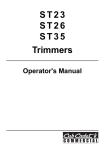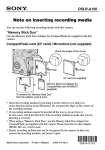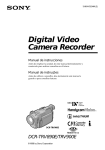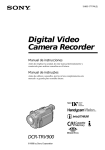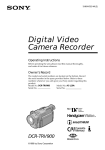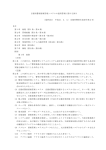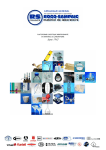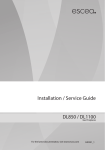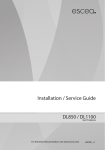Download Sony MSAC-PR1 User's Manual
Transcript
3-867-219-11 (1) PC Card/ Parallel Port Adaptor Operating Instructions __________________ GB Mode d’emploi ________________________ FR MSAC-PR1 © 1999 by Sony Corporation Safety Regulations WARNING To prevent fire or shock hazard, do not expose the unit to rain or moisture. For the customers in the United States Declaration of Conformity Trade Name: SONY Model No.: MSAC-PR1 Responsible Party: Sony Electronics Inc. Address: 1 Sony Drive, Park Ridge, NJ, 07656 USA Telephone No.: 201-930-6970 This device complies with Part 15 of the FCC Rules. Operation is subject to the following two conditions.: (1) This device may not cause harmful interference, and (2) this device must accept any interference received, including interference that may cause undesired operation. CAUTION You are cautioned that any changes or modifications not expressly approved in this manual could void your authority to operate this equipment. Note: This equipment has been tested and found to comply with the Limits for a Class B digital device, pursuant to Part 15 of the FCC Rules. These limits are designed to provide reasonable protection against harmful interference in a residential installation. This equipment generates, uses, and can radiate radio frequency energy and, if not installed and used in accordance with the instructions, may cause harmful interference to radio communications. However, there is no guarantee that interference will not occur in a particular installation. If reception, which can be determined by turning the equipment off and on, the user is encouraged to try to correct the interference by one or more of the following measures: – Reorient or relocate the receiving antenna. – Increase the separation between the equipment and receiver. – Connect the equipment into an outlet on a circuit different from that to which the receiver is connected. – Consult the dealer or an experienced radio/TV technician for help. For the customers in Germany Directive: EMC Directive 89/336/EEC. 92/31/EEC This equipment complies with the EMC regulations when used under the following circumstances: – Residential area – Business district – Light-industry district (This equipment complies with the EMC standard regulations EN55022 Class B.) Table of Contents Introduction ................................................................................. 2 Packing List .................................................................................. 3 Part Names and Connections ..................................................... 4 Driver Installation ....................................................................... 6 Installing the Driver ............................................................................. 6 Changing Settings for Installation ................................................... 13 Uninstalling the Driver ...................................................................... 17 Operating the MSAC-PR1 ......................................................... 18 18 19 20 21 Troubleshooting ........................................................................ 22 Compatible Equipment ............................................................. 24 Specifications ............................................................................. 26 1 GB GB English Inserting a PC card ............................................................................. Removing a PC card ........................................................................... Instructions for Memory Stick .......................................................... Changing the Drive Name ................................................................ Introduction The PC Card/ Parallel Port Adaptor MSAC-PR1 used with the Sony Memory Stick PC Card Adaptor allows data to be read and written data using a desktop PC. Required System Environment • A PC Card Adaptor for use with a Sony Memory Stick is recommended. • A Microsoft Windows 95/98/NT 4.0 OS. • A desktop type IBM PC/AT compatible PC, with D-sub25 parallel port connector and a PS/2 or AT type keyboard connector. • Cannot be used with anything other than the printer being connected to the parallel port of the machine. • This device supports ATA flashcards but operations with these cannot be guaranteed. • See page 24 for confirmed compatible equipment. ❏ No part of the software bundled with this equipment or this User’s Guide may be reproduced in any form, nor may the software be lent or rented without prior permission from Sony Corporation. ❏ Sony Corporation disclaims all liability for any damage or loss resulting from the use of this equipment or the bundled software, and for all claims from any third parties. Please be sure to back up any important data. ❏ Please refer to the warranty card provided with this product for the warranty terms and conditions. ❏ The software bundled with this equipment must not be used in a system other than that with which it is provided. ❏ Sony Corporation reserves the right to change the specifications of this equipment and the bundled software without notice. Memory Stick is a trademark of Sony Corporation. Microsoft and Windows are registered trademarks of the Microsoft Corporation in the United States and other regions. IBM and PC/AT are registered trademarks of the IBM Corporation in the United States and other regions. Other company names and product names appearing in this document are registered trademarks of those companies respectively. 2 GB Packing List Confirm that the items below have been supplied. If something has not been supplied, contact your supplier or local Sony Service personal. • PC Card/ Parallel Port Adaptor (MSAC-PR1) • Power cable • Reverse connector • Setup Disc CD-ROM (1) • Instruction Manual Caution The power cable supplied is for use only with the PC Card/Parallel Port Adaptor. It cannot be used for connection with any other kind of equipment. 3 GB Part Names and Connections Turn the PC and all peripheral equipment off and disconnect the keyboard plug from the PC before performing the connection operations. 5 6 0 !¡!£ !™ !¶ 1 2 3 4 7 9 8 !∞ !¢ !§ 1 PC card socket Insert the PC card here. 2 Eject button Press this to remove the PC card. 3 PC Card/Parallel Port Adaptor 4 Power/Access lamp This lamp illuminates when the power is on. It blinks when data is being accessed. Caution Do not disconnect the PC card or Memory Stick while the Power access lamp is blinking, as it may cause internal damage to the PC card or the Memory Stick. 4 GB 5 Printer cable If you are not going to use the parallel port connector !¡ with the printer, it is not necessary to connect the printer cable 6 to the connector. 6 Printer connector (D-sub 25-pin) (female) If you are going to use the parallel port connector !¡ with the printer, the printer cable is connected here once the MSAC-PR1 driver has been installed. When you connect the connector, make sure that it is the right way up. Trying to force the connector in can cause damage. 7 DC jack 8 Power connection cable 9 DC plug 0 D-sub 25-pin connector (male) !¡ PC parallel port D-sub 25-pin connector (female) If there are more than two connectors, connect to LPT 1. !™ PC !£ PC keyboard connector !¢ Mini DIN 6-pin connector (male) !∞ DIN 5-pin connector (male) Connect the PC keyboard connector !£ to the PC with either of the 2 DIN plugs !¢ !∞. !§ Reverse connector For connecting the DIN connectors !¢ or !∞ to the keyboard plug !¶ !¶ Keyboard plug 5 GB Driver Installation Install the driver with the printer disconnected. If you are using Windows NT 4.0, log on as an administrator. Caution The screen examples shown in this manual are in English. However, the language used for screen display depends on the selection made when the driver is installed. Please select the language that matches that of your computer’s operating system. Installing the Driver 1 Insert the supplied CD-ROM into the CD-ROM drive on the computer. The “Sony MSAC-PR1 Setup” window appears. If the CD-ROM automatic run has not been set, open the CD-ROM drive with the Explorer and double click “autorun.exe” to display the menu. Alternatively you can directly specify “X:\ Utility\Setup.exe” (X is the CD-ROM drive name) to start the installer. 6 GB 2 Click “Install Sony MSAC-PR1 Drivers” with the mouse cursor. The Setup Language window appears. 3 Select language and click “Next.” The “Welcome” window appears. At the beginning of the installation a warning appears. It is necessary to close all other applications for the MSACPR1 to be installed correctly. 4 Click the “Next” button. 7 GB The “Software License Agreement” window appears. 5 Click “Yes” if you agree with all the conditions in the contract. Once you agree with all the conditions in the license agreement, you can use MSAC-PR1. 6 Parallel port sharing (Windows NT 4.0 only) Select “Yes, I want to share my parallel port” if you are to use the MSAC-PR1 printer connector as well as another printer connected. 8 GB The “Choose Destination Location” window appears. 7 The file path name for the installation appears. Click the “Next” button. If you want to change the directory for the installation, specify the path in the box and then click the “Next” button. The “Select Program Folder” window appears. 8 The program names registered in the start menu appear. Click “Next.” If you want to change the file name, input the name and then click “Next.” 9 GB The “Start Copying Files” window appears. 9 Check the contents of the installation settings and click “Next.” The file copying commences and MSAC-PR1 is registered in the system. The driver is loaded when the files have finished being copied. Caution The cursor will be immobilized for about 10 seconds while the driver is being loaded. If the cursor remains immobile on the screen after loading is complete, it may be that the BIOS settings in the PC are not suitable for MSAC-PR1. You will need to change the BIOS settings. For details, refer to “Changing Settings for Installation” A (page 13) and B (page 14) to change the BIOS settings. 10 GB Further, If the “Hardware Initialization Failure” window appears, select “I will connect the MSAC-PR1 later” to shut down the setup, and then recheck the connections. • Make sure the 25-pin connector is firmly connected to the parallel port. • The power to the MSAC-PR1 must be on. Insert the power connection cable associated with the keyboard connector of the PC, and connect it to the DC jack of the MSAC-PR1. If the “Removable Disk” icon does not appear on restarting the PC even with the PC card inserted, it may be that the BIOS settings in the PC are not set correctly for MSAC-PR1. You will need to change the BIOS settings. For details, refer to “Changing Settings for Installation” A (page 13) and B (page 14) to change the BIOS settings. 11 GB 10 Device Selection (Windows NT 4.0 only) With Windows NT 4.0, the following screen appears. Click the “OK” button. 11 Setup Complete With Windows 95/98 you can use the PC card straight away. With Windows NT4.0, you have to restart the computer before you can use the PC card. 12 Connecting the Printer Turn the power to the PC off and connect the printer. If the printer does not run normally. Refer to “Changing Settings for Installation” C (page 15) and D (page 16). Installing a new printer. Turn the PC off, remove the device from the PC, and then connect the printer cable directly to the parallel port. After installing the printer driver, reconnect the printer cable to the printer connector of this device, and perform a test print. If the printing is unsatisfactory, refer to “Changing Settings for Installation” C (page 15) and D (page 16). 12 GB Changing Settings for Installation The driver does not install satisfactorily. If the response from the PC is lost during installation or an error occurs, it may be that the parallel port settings in the BIOS of the PC are not suited to the MSAC-PR1. By changing the parallel port BIOS settings and adding parameters to the driver, the situations above can be rectified. A Changing the Parallel Port BIOS Settings The method for changing the parallel port BIOS settings and the screens that are displayed vary according to the type of computer that you are using. Refer to the instruction manual for you computer for information regarding changing the settings. Method for Changing Settings (example) 1 Start the computer. 2 When the computer is powered up, A message “Press xx for setting” appears at the bottom of the screen before the operating system (Windows etc) screens appear. (For a computer that complies with the Energy Star standard, this message appears at the top right corner of the Energy Star logo screen.) Press the (xx) button as instructed by the message before the message disappears from the screen. Pressing the (xx) button invokes the BIOS settings screen. Some computers do not display this message for BIOS settings. Refer to the instruction manual for the computer for more information. 3 In most BIOS setting screens, there are 2 procedural steps that invoke the screens for actually making the settings. First of all, start from the screen that has the parallel port settings item in it. (Usually you will not know from the first screen which screen contains the parallel port settings and will have to refer to the instruction manual for the computer to open the screen for the parallel port settings.) 4 BIOS setting possibilities vary from computer to computer, however, normally the following options are available: Auto→Enable→Disable EPP→ECP→SPP→Bi-directional (Some computers only have the first two options.) Make the settings in the following way: Auto→Enable→Disable Set to Enable EPP→ECP→SPP→Bi-directional Check operations with each setting. 13 GB B Adding MSAC-PR1 device driver parameters (for Windows 95/98 only) If the MSAC-PR1 does not function normally, add device driver parameters according to the following procedure. 1 Select “Properties” from the context menu when you right click over “This Computer” or double click “System” in the control panel to open the system properties window. 2 Double click the device manager tab, then double click SCSI controller category to display “Sony MSAC-PR1” in the device list. 3 Double click “Sony MSAC-PR1” to display the Properties window and then click the Settings tab. 4 The adaptor setting will be “/flash/W95.” Add “/ni /de /di” to this and click “OK,” making sure there is a space before each slash. 14 GB 5 Click “OK” in “Sony MSAC-PR1” properties. 6 Click the “OK” button in “System properties” and a message promoting you to restart the computer will be displayed. Restart the computer. Caution On some machines the computer may not restart or the MSAC-PR1 may not function normally with this procedure. If this happens, erase only the parameters that you added to return the adaptor setting to “/flash/W95.” The printer does not work well If a printer which was functioning normally ceases to do so after installing MSAC-PR1, or a newly installed printer does not function properly, this can be rectified by closing all applications not directly related to printing and changing the printer driver settings. C Deleting an application from the start up folder Depending on the type of printer you are using, the parallel port may be occupied by some other application installed at the time of printer driver installation. Such applications are automatically placed in the task tray when the computer is started, interrupting communications between the PC and MSAC-PR1, resulting in a printer malfunction to be mistakenly recognized and an error to be displayed. 15 GB Refer to the instruction manual for the printer to check whether such applications have been installed, and if they are, close them and perform a test print. If the test print is successful, go to “Add/Remove Programs” in the “Control Panel” and uninstall the application, or delete the short cut from the start up folder. Such permanent applications are nearly always registered in the start up folder. By deleting these applications from the start up folder they will not be launched when the computer is restarted. 1 Click “ Start” on the taskbar. 2 Click “Taskbar” in “Settings” to open the “Taskbar Properties” window. 3 Click the “Start Menu Programs” tab. 4 Click “Remove” to display the “Remove Shortcuts/Folders” window. 5 Double click “StartUp” to display the application shortcuts. 6 Select the application shortcut you wish to delete and then click “Remove”. 7 Click “Close” and the “Remove Shortcuts/Folders” window closes. 8 Click “OK” to close the “Taskbar Properties” window. D Changing Printer Driver Settings If “Enable bi-directional support for this printer” have been selected in the printer driver settings, either or both the printer and the MSAC-PR1 will not function normally. In this case, change the settings to “Disable bi-directional support for this printer” by the following procedure: 1 Click “Start” on the taskbar. 2 Click “Settings” and click “Printers” to display a list of printers. 3 Right click on the printer to which the MSAC-PR1 connector is connected to open the properties sheet. 4 Click the details tab, and click “Spool Settings.” 5 Click the “Disable bi-directional support for this printer” radio button and click “OK.” 6 Click the “OK” button to close the Properties sheet. 16 GB Uninstalling the Driver The MSAC-PR1 driver can be deleted from the PC by the following procedure if it is no longer needed. 1 Click “Start” on the taskbar and then click “UNINSTALL” in “Sony MSAC-PR1” in “Programs.” A window for confirming uninstallation is displayed. 2 Click “Yes.” The uninstall program starts. A window with “Remove Programs From Your Computer” is displayed and the deletion of files commences. 3 When the uninstallation is complete, click the “OK” button. 17 GB Operating the MSAC-PR1 Inserting a PC card To use a PC card, insert the card into the PC Card/Parallel port adaptor. Caution The Sony PC Card Adaptor for Memory Stick is recommended. 1 2 1 Check that the power/access lamp is illuminated. 2 Making sure the ▲ mark is on top, insert the PC card into the slot gently. Push the PC card firmly all the way in. Icon display When a PC card or Memory Stick is inserted when using Windows 95/98, a “Removable Disk” icon is displayed. This icon disappears when the card or Memory Stick is removed. With Windows NT, the “Removable Disk” icon is displayed when the PC is started even if there is no PC card or Memory Stick inserted. There is no recycle bin for Removable Disks Care must be taken when erasing files from removable disks, as these files are erased immediately without being transferred to the recycle bin. 18 GB Make backup copies of important data and files to some other media. Access When accessing large files, an increased load is placed on the computer and the movement of the cursor may be lost or other processing stopped. Wait until the file accessing has finished. Removing a PC card 1 2 1 Check that the power/access lamp is not blinking. Caution Do not remove a PC card or Memory Stick while the power/ access lamp is blinking. If the card is removed while the lamp is blinking, damage to the card or Memory Stick may occur. Also, even when the lamp stops blinking, some processing may still be taking place. To be safe, wait a while after the lamp has stopped blinking before removing the card or Memory Stick. 2 Press the eject button and gently remove the card. Caution Do not attempt to remove, insert or access a PC card or Memory Stick while the printer is printing. Printing may be halted, and a printing error may be displayed. Do not touch the connections of a PC card or Memory Stick with you hands or metal object as this may result in damage. 19 GB Instructions for Memory Stick Memory Stick Operation This device only supports the insertion and removal of Memory Stick. With a PC Card Adaptor for Memory Stick inserted into the device, only a Memory Stick can be inserted. When removing a Memory Stick, gently press the Memory Stick eject button to prevent the Memory Stick from flying out. The PC does not recognize the state of the erase protect switch. If the PC card is used with the switch in the “LOCK” position the response from the PC will be slow and data reading/ writing errors may occur. Use the card with the switch released. Further, make backup copies of important data and files to some other media. Memory Stick Format (initialization) The Memory Stick comes supplied from the factory with a suitable format. Please do not attempt to format it. If the Memory Stick is reformatted by the PC it will not be in a suitable condition to be read or written by other equipment that supports Memory Stick. If this happens, the Memory Stick can be used after it has been reformatted by the other equipment with which it is to be used. 20 GB Changing the Drive Name If you are using a Windows 95/98 computer, The drive name for MSAC-PR1 can be changed with the following procedure: 1 Click the right button on “My Computer” and select “Properties” from the context menu or double click “System” in the control panel to display “System Properties.” 2 Click the Device Manager tab and double click Disk Drive Category. All connected drives are displayed. 3 Double Click “Parallel Flash Unit” The Properties window appears. 4 Click the Settings tab, and change the display for the starting drive. The next time Windows is started, this will be the drive name. 21 GB Troubleshooting Before sending the equipment for repair, please check the following points. If the equipment still fails to function normally after you have checked everything, consult your local Sony service personnel. Please refer to your PC Operating Manual. Symptom Cause/Action The MSAC-PR1 connector is connected to a printer but an error occurs and printing cannot be done. Or, reading/writing data cannot be done to the PC card. There is some permanent application that keeps watch over the state of the printer. Printing cannot be done and the computer does not recognize the PC card in the normal way. Close the permanent application. Cause/Action The parallel port settings on the computer are incorrect. Try changing the BIOS settings. Cause/Action The printer is incompatible with this device. Some printers cannot be used when connected to the MSACPR1 printer connector. Symptom When writing or reading from Memory Stick, a disk writing error is displayed on a blue screen, with a warning message that files or data may have been lost. Cause/Action The Memory Stick erase protect switch is set to the “LOCK” position. Release the LOCK on the Memory Stick. The data in the Memory Stick will not be lost. 22 GB Symptom The data recorded in the PC card is flawed. Cause/Action The PC card was removed while being accessed from the computer. When the hour glass mark is being displayed during accessing, the power/access lamp blinks. Allow ample time after the lamp stops blinking before removing the PC card. Symptom The PC card cannot be inserted all the way into the PC Card Adaptor. Cause/Action Some foreign object is lodged in the card slot of the PC Card Adaptor. Remove the foreign object. Damage may occur to the internal connector in this case. 23 GB Compatible Equipment • Printers whose Compatibility has been Confirmed HP LaserJet IIP/HP LaserJet 5L/ HP DeskJet 692/ HPDeskJet 720C EPSON LQ-1010C/EPSON LQ-200/EPSON LQ-2070C Canon BJC-330/Canon BJC-400J/Canon BJC-430J/ Canon BJC-4000/Canon BJC-4300 Fujitsu DL1100/ALPS MD-1000J/ALPS MD-2000J Sony DPP-M55 • PC Cards whose Compatibility has been Confirmed Hitachi HB286008A3, HB286015A3, HB286030A3, HB286045A3, HB286060A3 SanDisk SDP3B-2-101-00, SDP3B-4-101-00, SDP3B-2-6-101-00, SDP3B-8-101-00, SDP3B-10-101-00, SDP3B-20-101-00 I-O DATA DEVICE PCFCA-10MS, PCFCA-20MS, PCFCA-40MS PCFCA-85M MELCO DPF-10J, DPF-20J, DPF-40J SCM Microsystems PCF-10, PCF-20, PCF-40 24 GB EPSON EP10, EP20, EP40, EP85 Panasonic BN-012ABP3, BN-020ABP3 TDK SFD004M, SFD012M, SFD024M, SFD032M, SFD096M HAGIWARA SYS-COM HPC-FC20M 25 GB Specifications Parallel Port/PC Card Adaptor for Memory Stick (MSACPR1) Supported OS Windows 95/Windows 98/Windows NT 4.0 Compatible PCs IBM PC/AT compatible (desktop type) • D-sub 25-pin parallel port connector and PS/ 2 or AT type keyboard connector required. • Normal operation cannot be guaranteed with notebook computers. Dimensions 83mm×21mm×124mm(W×H×D) Mass 150g approx. Power source (Voltage) DC5V (supplied from keyboard connector) Current consumed 150mA approx. Environmental conditions 0ºC-40ºC, 32ºF-104ºF (no condensation) Host interface Parallel port (IEEE1284.3 compliant) Connector Computer side: D-sub 25-pin (male) <parallel port (IEEE1284.3 compliant)> Printer side: D-sub 25-pin (female) <parallel port (IEEE1284.3 compliant)> • The device cannot be used if there is any other equipment connected to the parallel port. (scanner or other cartridge etc.) Compatible PC cards PCMCIA compliant ATA/IDE specifications • Recommended PC Cards Sony: Memory Stick/PC Card Adaptor (MSAC-PC1) <for use with Memory Stick > 26 GB Table des matiéres Introduction ................................................................................. 2 Contenu de l’emballage .............................................................. 3 Nom des pièces et connexions ................................................... 4 Installation du pilote ................................................................... 6 Installation du pilote ............................................................................ 6 Réglage des paramètres d’installation ............................................. 13 Désinstallation du pilote .................................................................... 17 Utilisation du MSAC-PR1 .......................................................... 18 Insertion d’une carte PC .................................................................... Retrait la carte PC ............................................................................... Instructions relatives au Memory Stick ........................................... Changement de nom du lecteur ....................................................... 18 19 20 21 Matériel compatible .................................................................. 24 Fiche technique ......................................................................... 26 1 FR FR Français Dépannage ................................................................................ 22 Introduction L’adaptateur de port parallèle/carte PC MSAC-PR1 utilisé avec l’adaptateur de carte PC pour Memory Stick Sony vous permet de lire et d’écrire des données à l’aide d’un PC de bureau. Configuration minimale • Il est recommandé de disposer d’un adaptateur de carte PC pour Memory Stick Sony. • Système d’exploitation Microsoft Windows 95/98/NT 4.0 • PC de bureau compatible IBM PC/AC, avec connecteur de port parallèle D-sub 25 broches et connecteur de clavier de type PS/2 ou AT • Ne peut être utilisé qu’avec l’imprimante raccordée au port parallèle de la machine. • Ce périphérique supporte les cartes flash ATA, mais les opérations avec ces cartes ne sont pas garanties. • Pour le matériel compatible confirmé, voyez page 24. ❏ Aucune partie du logiciel livré avec l’appareil ou du guide de l’utilisateur ne peut être reproduite, sous quelque forme que ce soit, et le logiciel ne peut être prêté ou loué, sans autorisation préalable de Sony Corporation. ❏ Sony Corporation ne saurait être tenu responsable des dommages ou pertes résultant de l’utilisation de cet appareil ou du logiciel qui l’accompagne, ni des revendications émanant d’un tiers. Faites une copie de sauvegarde des données importantes. ❏ Pour les conditions de garantie, voyez la carte de garantie qui accompagne l’appareil. ❏ Le logiciel qui accompagne l’appareil ne devra être utilisé sur aucun autre système que celui avec lequel il est livré. ❏ Sony Corporation se réserve le droit de modifier les spécifications de l’appareil et du logiciel qui l’accompagne sans préavis. Memory Stick est une marque de Sony Corporation. Microsoft et Windows sont des marques déposées de Microsoft Corporation aux Etats-Unis et dans d’autres régions. IBM et PC/AT sont des marques déposées de IBM Corporation aux Etats-Unis et dans d’autres régions. Les autres noms de société et de produit qui apparaissent dans ce document sont des marques déposées des entreprises respectives. 2 FR Contenu de l’emballage Vérifiez si les articles ci-dessous se trouvent bien tous dans l’emballage. S’il manque un article, contactez votre fournisseur ou votre service après-vente Sony. • Adaptateur de port parallèle/carte PC (MSAC-PR1) • Câble d’alimentation • Connecteur inverse • Disque de configuration CD-ROM (1) • Mode d’emploi Attention Le câble d’alimentation fourni a été conçu exclusivement pour l’adaptateur de port parallèle/carte PC. Ne le raccordez à aucun autre périphérique. 3 FR Nom des pièces et connexions Mettez le PC et tous les périphériques hors tension et débranchez la fiche du clavier au niveau du PC avant de procéder aux connexions. 5 6 0 !¡!£ !™ !¶ 1 2 3 4 7 9 8 !∞ !¢ !§ 1 Emplacement de carte PC C’est là que vous insérez la carte PC. 2 Touche d’éjection Appuyez sur cette touche pour retirer la carte PC. 3 Adaptateur de port parallèle/carte PC 4 Voyant d’alimentation/accès Ce voyant s’allume lorsque l’appareil est sous tension. Il clignote pendant l’accès aux données. Attention Ne déconnectez pas la carte PC ni le Memory Stick pendant que le voyant d’alimentation/accès clignote. Vous pourriez endommager l’intérieur de la carte PC ou du Memory Stick. 4 FR 5 Câble d’imprimante Si vous ne prévoyez pas d’utiliser le connecteur de port parallèle !¡ avec l’imprimante, vous n’aurez pas besoin de raccorder le câble d’imprimante 6 au connecteur. 6 Connecteur d’imprimante (D-sub 25 broches) (femelle) Si vous prévoyez d’utiliser le connecteur de port parallèle !¡ avec l’imprimante, raccordez le câble d’imprimante à ce connecteur après avoir installé le pilote du MSAC-PR1. Quand vous raccordez le connecteur, veillez bien à ce qu’il soit dirigé dans le bon sens. Vous risquez d’endommager le connecteur si vous l’insérez de force. 7 Prise CC 8 Câble de connexion d’alimentation 9 Fiche CC 0 Connecteur D-sub 25 broches (mâle) !¡ Connecteur D-sub 25 broches de port parallèle du PC (femelle) S’il y a plus de deux connecteurs, raccordez-le à LPT 1. !™ PC !£ Connecteur de clavier du PC !¢ Connecteur mini DIN 6 broches (mâle) !∞ Connecteur DIN 5 broches (mâle) Raccordez le connecteur de clavier du PC !£ au PC avec l’une ou l’autre des 2 fiches DIN !¢ !∞. !§ Connecteur inverse Pour la connexion des connecteurs DIN !¢ ou !∞ à la fiche du clavier !¶ !¶ Fiche du clavier 5 FR Installation du pilote Installez le pilote après avoir débranché l’imprimante. Si vous travaillez sous Windows NT 4.0, ouvrez la session comme administrateur. Attention Les exemples d’écran qui figurent dans ce manuel sont rédigés en anglais. Néanmoins, la langue des affichages à l’écran dépend de la sélection effectuée au moment de l’installation du pilote. Sélectionnez la langue du système d’exploitation de votre ordinateur. Installation du pilote 1 Insérez le CD-ROM fourni dans le lecteur de CDROM de l’ordinateur. La fenêtre “Sony MSAC-PR1 Setup” (Configuration du MSAC-PR1 Sony) s’affiche. Si vous n’avez pas réglé l’exécution automatique du CDROM, ouvrez le lecteur du CD-ROM avec Explorer et double-cliquez sur “autorun.exe” pour afficher le menu. Ou bien, vous pouvez spécifier directement “X:\Utility\Setup.exe” (X représentant le nom du lecteur de CD-ROM) pour démarrer l’installateur. 6 FR 2 Cliquez sur “Install Sony MSAC-PR1 Drivers” (Installer les pilotes du MSAC-PR1 Sony” avec le curseur de la souris. La fenêtre Setup Language (Configuration de la langue) s’affiche. 3 Sélectionnez la langue et cliquez sur “Next” (Suivant). La fenêtre “Welcome” (Bienvenue) s’affiche. Au début de l’installation, un avertissement s’affiche. Pour pouvoir effectuer correctement l’installation du MSACPR1, vous devrez fermer toutes les autres applications. 4 Cliquez sur le bouton “Next” (Suivant). 7 FR La fenêtre “Software License Agreement” (Accord de licence de logiciel) s’affiche. 5 Cliquez sur “Yes” (Oui) si vous acceptez toutes les conditions du contrat. Une fois que vous avez accepté toutes les conditions de l’accord de licence, vous pouvez utiliser le MSAC-PR1. 6 Partage du port parallèle (Windows NT 4.0 uniquement) Sélectionnez “Yes, I want to share my parallel port” (Oui, je veux partager mon port parallèle) si vous voulez utiliser le connecteur d’imprimante du MSAC-PR1 ainsi qu’une autre imprimante raccordée. 8 FR La fenêtre “Choose Destination Location” (Sélectionner l’emplacement de destination) s’affiche. 7 Le nom du chemin de fichier d’installation s’affiche. Cliquez sur le bouton “Next” (Suivant). Si vous voulez effectuer l’installation dans un autre répertoire, spécifiez le chemin dans la boîte, et cliquez sur le bouton “Next” (Suivant). La fenêtre “Select Program Folder” (Sélectionnez le dossier du programme) s’affiche. 8 Les noms des programmes enregistrés dans le menu Start (Démarrer) s’affichent. Cliquez sur “Next” (Suivant). Si vous voulez changer le nom du fichier, tapez le nom et cliquez sur “Next” (Suivant). 9 FR La fenêtre “Start Copying Files” (Démarrer la copie des fichiers) s’affiche. 9 Vérifiez le contenu des paramètres d’installation et cliquez sur “Next” (Suivant). La copie des fichiers démarre, et le MSAC-PR1 est enregistré dans le système. Le pilote est chargé lorsque tous les fichiers ont été copiés. Attention Le curseur s’immobilise pendant environ 10 secondes pendant le chargement du pilote. Si le curseur reste immobile à l’écran alors que le chargement est terminé, il est possible que les paramètres BIOS du PC ne conviennent pas pour le MSAC-PR1. Vous devrez modifier les paramètres BIOS. Pour les détails sur le réglage des paramètres BIOS, voyez la section “Réglage des paramètres d’installation” A (page 13) et B (page 14). 10 FR Par ailleurs, si la fenêtre “Hardware Initialization Failure” (Echec d’initialisation du matériel) s’affiche, sélectionnez “I will connect the MSAC-PR1 later” (Je vais raccorder le MSAC-PR1 plus tard) pour fermer la configuration, et revérifiez les connexions. • Vérifiez que le connecteur à 25 broches est bien raccordé à fond dans le port parallèle. • Il faut que le MSAC-PR1 soit sous tension. Raccordez le câble de raccordement d’alimentation associé au connecteur de clavier du PC, et branchez-le dans la prise DC du MSAC-PR1. Si l’icône “Removable Disk” (Disque amovible) ne s’affiche pas au redémarrage du PC bien que vous ayez inséré la carte PC, il est possible que les paramètres BIOS du PC ne conviennent pas pour le MSAC-PR1. Vous devrez modifier les paramètres BIOS. Pour les détails sur le réglage des paramètres BIOS, voyez la section “Réglage des paramètres d’installation” A (page 13) et B (page 14). 11 FR 10 Sélection du périphérique (Windows NT 4.0 uniquement) Sous Windows NT 4.0, l’écran suivant s’affiche. Cliquez sur le bouton “OK”. 11 Configuration terminée Sous Windows 95/98, vous pouvez utiliser la carte PC directement. Sous Windows NT 4.0, vous devrez redémarrer l’ordinateur pour pouvoir utiliser la carte PC. 12 Raccordement de l’imprimante Mettez le PC hors tension et raccordez l’imprimante. Si l’imprimante ne fonctionne pas normalement Voyez la section “Réglage des paramètres d’installation” C (page 15) et D (page 16). Installation d’une nouvelle imprimante Mettez le PC hors tension, débranchez le périphérique du PC, puis raccordez le câble d’imprimante directement au port parallèle. Après avoir installé le pilote d’imprimante, rebranchez le câble d’imprimante dans le connecteur d’imprimante de ce périphérique, et effectuez un essai d’impression. Si l’impression n’est pas satisfaisante, voyez la section “Réglage des paramètres d’installation” C (page 15) et D (page 16). 12 FR Réglage des paramètres d’installation L’installation du pilote n’est pas satisfaisante. Si vous perdez la réponse du PC pendant l’installation ou qu’il se produit une erreur, il est possible que les réglages du port parallèle dans le BIOS du PC ne conviennent pas pour le MSAC-PR1. Vous pourrez corriger la situation en modifiant les paramètres BIOS du port parallèle et en ajoutant des paramètres au pilote. A Réglage des paramètres BIOS du port parallèle La méthode de réglage des paramètres BIOS du port parallèle et des écrans qui s’affichent varie en fonction de votre ordinateur. Pour les informations sur le réglage des paramètres, voyez le mode d’emploi de votre ordinateur. Méthode de réglage des paramètres (exemple) 1 Démarrez l’ordinateur. 2 Lorsque l’ordinateur est sous tension, un message “Press xx for setting” (Appuyez sur xx pour régler) s’affiche au bas de l’écran avant que les écrans du système d’exploitation (Windows, etc.) n’apparaissent. (Avec un ordinateur respectant la norme Energy Star, ce message s’affiche en haut et à droite de l’écran renfermant le logo Energy Star). Appuyez sur la touche (xx) comme indiqué dans le message avant que le message ne disparaisse de l’écran. Quand vous appuyez sur la touche (xx), l’écran de réglage du BIOS apparaît. Certains ordinateurs n’affichent pas ce message pour le réglage du BIOS. Pour tout complément d’information, reportez-vous au mode d’emploi de l’ordinateur en question. 3 Sur la plupart des écrans de réglage du BIOS, vous devez effectuer deux opérations pour rappeler les écrans afin de régler les paramètres. Commencez par l’écran qui renferme la rubrique de réglage du port parallèle. (Généralement, vous ne pouvez pas dire en voyant ce premier écran quel est l’écran qui renferme les paramètres du port parallèle, et vous devrez vous reporter au mode d’emploi de l’ordinateur pour ouvrir l’écran de réglage du port parallèle.) 4 Les possibilités de réglage du BIOS varient d’un ordinateur à l’autre. Néanmoins, vous disposez généralement des options suivantes : Auto → Enable → Disable [Automatique → Valider → Invalider] EPP → ECP → SPP → Bi-directional [EPP → ECP → SPP → Bidirectionnel] (Certains ordinateurs ne possèdent que ces deux premières options.) Réglez les paramètres de la façon suivante : Auto → Enable → Disable [Automatique → Valider → Invalider] - Réglez sur Enable (Valider). EPP → ECP → SPP → Bi-directional [EPP → ECP → SPP → Bidirectionnel] Vérifiez les opérations avec chaque paramètre. 13 FR B Ajout des paramètres du pilote de périphérique du MSAC-PR1 (sous Windows 95/98 seulement) Si le MSAC-PR1 ne fonctionne pas normalement, ajoutez les paramètres du pilote de périphérique en procédant de la façon suivante. 1 Sélectionnez “Properties” (Propriétés) dans le menu contexte quand vous cliquez avec le bouton droit sur “This Computer” (Cet ordinateur), ou double-cliquez sur “System” (Système) dans le panneau de configuration pour ouvrir la fenêtre des propriétés système. 2 Double-cliquez sur l’onglet du gestionnaire de périphérique, puis doublecliquez sur la catégorie de contrôleur SCSI pour afficher “Sony MSAC-PR1” dans la liste des périphériques. 3 Double-cliquez sur “Sony MSAC-PR1” pour afficher la fenêtre des propriétés, puis cliquez sur l’onglet Settings (Paramètres). 4 Le paramètre d’adaptateur s’affiche comme “/flash/W95”. Ajoutez-y “/ni / de /di”, et cliquez sur “OK” en veillant bien à taper un espace avant chaque barre oblique. 14 FR 5 Cliquez sur “OK” dans les propriétés de “Sony MSAC-PR1”. 6 Cliquez sur le bouton “OK” dans “System properties” (Propriétés système) ; un message vous demande de redémarrer l’ordinateur. Redémarrez l’ordinateur. Attention Avec certains ordinateurs, l’ordinateur peut ne pas redémarrer, ou le MSAC-PR1 peut ne pas fonctionner normalement avec cette procédure. Dans ce cas, supprimez uniquement les paramètres que vous avez ajoutés pour ramener l’adaptateur au réglage “/flash/W95”. L’imprimante ne fonctionne pas correctement Si l’imprimante ne fonctionne plus correctement après l’installation de MSACPR1 alors qu’elle fonctionnait normalement avant, ou si une imprimante nouvellement installée ne fonctionne pas correctement, vous pourrez corriger la situation en fermant toutes les applications non directement liées à l’impression et en modifiant les paramètres du pilote d’imprimante. 15 FR C Suppression d’une application depuis le dossier de démarrage Selon le type de votre imprimante, il est possible que le port parallèle soit occupé par une autre application installée au moment de l’installation du pilote d’imprimante. Ces applications sont automatiquement placées dans le tiroir des tâches au démarrage de l’ordinateur, interrompant ainsi la communication entre le PC et le MSAC-PR1 ; un dysfonctionnement d’imprimante est alors reconnu par erreur, et une erreur s’affiche. Reportez-vous au mode d’emploi de l’imprimante pour vérifier si ces applications ont été installées, et si elles l’ont été, fermez-les et effectuez un essai d’impression. Si l’essai d’impression est satisfaisant, allez à “Add/Remove Programs” (Ajout/ Suppression de programmes) dans le “Panneau de configuration” et désinstallez l’application ; ou bien, supprimez le raccourci dans le dossier de démarrage. Ce genre d’applications permanentes est presque toujours enregistré dans le dossier de démarrage. En les supprimant du dossier de démarrage, elles ne seront plus lancées lorsque vous redémarrerez l’ordinateur. 1 Cliquez sur “Start” (Démarrer) dans la barre des tâches. 2 Cliquez sur “Taskbar” (Barre des tâches) dans “Settings” (Paramètres) pour ouvrir la fenêtre “Taskbar Properties” (Propriétés de la barre des tâches). 3 Cliquez sur l’onglet “Start Menu Programs” (Démarrer le menu des programmes). 4 Cliquez sur “Remove” (Supprimer) pour afficher la fenêtre “Remove Shortcuts/Folders” (Supprimer les raccourcis/dossiers). 5 Double-cliquez sur “Start” (Démarrer) pour afficher les raccourcis d’application. 6 Sélectionnez le raccourci d’application que vous voulez supprimer, et cliquez sur “Remove” (Supprimer). 7 Cliquez sur “Close” (Fermer). La fenêtre “Remove Shortcuts/Folders” (Supprimer les raccourcis/dossiers) se referme. 8 Cliquez sur “OK” pour fermer la fenêtre “Taskbar Properties” (Propriétés de la barre des tâches). 16 FR D Réglage des paramètres du pilote d’imprimante Si vous avez sélectionné “Enable bi-directional support for this printer” (Valider le support bidirectionnel pour cette imprimante) dans les paramètres du pilote d’imprimante, l’imprimante ou le MSAC-PR1 (ou les deux) ne fonctionneront pas normalement. Dans ce cas, réglez les paramètres sur “Disable bi-directional support for this printer” (Invalider le support bidirectionnel pour cette imprimante) en procédant de la façon suivante : 1 Cliquez sur “Start” (Démarrer) dans la barre des tâches. 2 Cliquez sur “Settings” (Paramètres), puis cliquez sur “Printers” (Imprimantes) pour afficher la liste des imprimantes. 3 Cliquez avec le bouton droit sur l’imprimante à laquelle le connecteur du MSAC-PR1 est connecté pour ouvrir la page des propriétés. 4 Cliquez sur l’onglet des détails, et cliquez sur “Spoul Settings” (Paramètres de spoule). 5 Cliquez sur le bouton radio “Disable bi-directional support for this printer” (Invalider le support bidirectionnel pour cette imprimante), puis cliquez sur “OK”. 6 Cliquez sur le bouton “OK” pour fermer la page des propriétés. Désinstallation du pilote Si vous n’avez plus besoin du pilote du MSAC-PR1, vous pouvez le supprimer du PC en procédant de la façon suivante. 1 Cliquez sur “Start” (Démarrer) dans la barre des tâches, puis cliquez sur “UNINSTALL” (Désinstaller) dans “Sony MSAC-PR1” de “Programs” (Programmes). Une fenêtre de confirmation de désinstallation s’affiche. 2 Appuyez sur “Yes” (Oui). Le programme de désinstallation démarre. Une fenêtre avec “Remove Programs From Your Computer” (Supprimer les programmes dans votre ordinateur) s’affiche, et la suppression des fichiers démarre. 3 Lorsque la désinstallation est terminée, cliquez sur le bouton “OK”. 17 FR Utilisation du MSAC-PR1 Insertion d’une carte PC Pour utiliser une carte PC, insérez la carte dans l’adaptateur de port parallèle/carte PC. Attention Nous vous recommandons d’utiliser l’adaptateur de carte PC Sony pour le Memory Stick. 1 2 1 Vérifiez si le voyant d’alimentation/accès est allumé. 2 Insérez la carte PC délicatement dans l’emplacement en veillant à ce que le repère ▲ soit dirigé vers le haut. Enfoncez la carte PC à fond. Affichage d’icône Si vous insérez une carte PC ou un Memory Stick lorsque vous travaillez sous Windows 95/98, une icône “Removable Disk” (Disque amovible) s’affiche. Cette icône disparaît lorsque vous retirez la carte PC ou le Memory Stick. Sous Windows NT, l’icône “Removable Disk” (Disque amovible) s’affiche au démarrage du PC, même si vous n’avez pas inséré de carte PC ou de Memory Stick. Il n’y a pas de corbeille pour les disques amovibles Faites attention lorsque vous supprimez les fichiers d’un disque amovible, car ces fichiers sont immédiatement effacés sans passer par la corbeille. 18 FR Faites des copies de sauvegarde des données et des fichiers importants sur un autre support. Accès Quand vous accédez à un gros fichier, une charge accrue est imposée à l’ordinateur, et le mouvement du curseur risque d’être perdu ou d’autres opérations de traitement d’être interrompues. Attendez que l’accès au fichier soit terminé. Retrait la carte PC 1 2 1 Vérifiez que le voyant d’alimentation/accès ne clignote pas. Attention Ne retirez pas la carte PC ni le Memory Stick alors que le voyant d’alimentation/accès clignote. Si vous retirez la carte pendant que le voyant clignote, vous risquez d’endommager la carte ou le Memory Stick. Par ailleurs, même si le voyant a cessé de clignoter, certaines opérations de traitement peuvent ne pas être complètement terminées. A titre de sécurité, attendez quelques instants après que le voyant a cessé de clignoter pour retirer la carte ou le Memory Stick. 2 Appuyez sur la touche d’éjection et retirez délicatement la carte. Attention N’essayez pas de retirer, d’insérer ou d’accéder à une carte PC ou un Memory Stick pendant que l’imprimante fonctionne. Vous risquez d’interrompre l’impression, et une erreur d’impression s’affichera. Ne touchez pas les connexions de la carte PC ni du Memory Stick avec les mains ni avec un objet métallique car vous pourriez provoquer des dommages. 19 FR Instructions relatives au Memory Stick Utilisation du Memory Stick Ce périphérique ne supporte que l’insertion et le retrait du Memory Stick. Si vous insérez un adaptateur de carte PC pour Memory Stick dans le périphérique, vous ne pourrez insérer qu’un Memory Stick. Pour retirer le Memory Stick, appuyez délicatement sur la touche d’éjection du Memory Stick pour éviter que le Memory Stick ne sorte brusquement de l’adaptateur. Le PC ne reconnaît pas l’état du commutateur de protection contre l’effacement. Si vous utilisez la carte PC avec le commutateur sur la position “LOCK” (Fermé), l’ordinateur répondra lentement et il risque de se produire des erreurs de lecture/écriture des données. Utilisez la carte avec le commutateur ouvert. Par ailleurs, faites des copies de sauvegarde des données et des fichiers importants sur un autre support. Format du Memory Stick (initialisation) Lorsque le Memory Stick quitte nos usines, il est prêt à l’emploi. N’essayez pas de le formater. Si le Memory Stick est reformaté par le PC, il ne sera plus dans un état lui permettant d’être lu ou écrit par un autre périphérique supportant le Memory Stick. Dans ce cas, vous devrez reformater le Memory Stick avec le périphérique avec lequel il doit être utilisé avant de pouvoir le réutiliser. 20 FR Changement de nom du lecteur Si votre ordinateur fonctionne sous Windows 95/98, vous pourrez changer le nom du lecteur du MSAC-PR1 en procédant de la façon suivante : 1 Cliquez le bouton droit sur “My computer” (Poste de travail) et sélectionnez “Properties” (Propriétés) dans le menu contexte, ou double-cliquez sur “System” (Système) dans le panneau de configuration pour afficher “System Properties” (Propriétés du système). 2 Cliquez sur l’onglet Device Manager (Gestionnaire de périphérique) et double-cliquez sur Disk Drive Category (Catégorie du lecteur de disque). Tous les lecteurs raccordés s’affichent. 3 Double-cliquez sur “Parallel Flash Unit” (Unité flash parallèle). La fenêtre des propriétés s’affiche. 4 Cliquez sur l’onglet Settings (Paramètres), et changez le paramètre affiché pour le lecteur de démarrage. La prochaine fois que vous démarrerez Windows, ce nom sera le nom du lecteur. 21 FR Dépannage Avant d’apporter le matériel à réparer, veuillez vérifier les points suivants. Si le matériel ne fonctionne toujours pas normalement après que vous ayez tout vérifié, consultez le personnel du service après-vente Sony. Veuillez vous reporter au mode d’emploi de votre PC. Symptôme Le connecteur du MSAC-PR1 est raccordé à une imprimante, mais il se produit une erreur et l’impression est impossible. Ou bien, il est impossible de lire/écrire des données sur la carte PC. Cause/Correction Il y a une application permanente qui surveille l’état de l’imprimante. L’impression est impossible et l’ordinateur ne reconnaît pas la carte PC normalement. Fermez l’application permanente. Cause/Correction Les paramètres du port parallèle de l’ordinateur sont mal réglés. Essayez de modifier les paramètres BIOS. Cause/Correction L’imprimante n’est pas compatible avec ce périphérique. Certaines imprimantes ne fonctionnent pas lorsqu’elles sont raccordées au connecteur d’imprimante du MSAC-PR1. Symptôme Lors d’une écriture ou d’une lecture sur le Memory Stick, une erreur d’écriture sur disque s’affiche sur un écran bleu, avec un message d’avertissement signalant que des fichiers ou des données ont pu être perdus. Cause/Correction Le commutateur de protection contre l’effacement du Memory Stick est réglé sur la position “LOCK” (Fermé). Ouvrez le commutateur LOCK du Memory Stick. Les données du Memory Stick ne seront pas perdues. 22 FR Symptôme The data recorded in the PC card is flawed. Cause/Correction Les données enregistrées sur la carte PC sont altérées. Vous avez retiré la carte PC pendant un accès à l’ordinateur. Lorsque le sablier est affiché pendant un accès, le voyant d’alimentation/accès clignote. Attendez suffisamment longtemps après que le voyant a cessé de clignoter pour retirer la carte PC. Symptôme Impossible d’insérer la carte PC à fond dans l’adaptateur de carte PC. Cause/Correction Il y a un corps étranger dans l’emplacement de l’adaptateur de carte PC. Retirez le corps étranger. Dans ce cas, vous risquez d’endommager le connecteur interne. 23 FR Matériel compatible • Imprimantes dont la compatibilité a été confirmée HP LaserJet IIP/HP LaserJet 5L/ HP DeskJet 692/ HPDeskJet 720C EPSON LQ-1010C/EPSON LQ-200/EPSON LQ-2070C Canon BJC-330/Canon BJC-400J/Canon BJC-430J/ Canon BJC-4000/Canon BJC-4300 Fujitsu DL1100/ALPS MD-1000J/ALPS MD-2000J Sony DPP-M55 • Cartes PC dont la compatibilité a été confirmée Hitachi HB286008A3, HB286015A3, HB286030A3, HB286045A3, HB286060A3 SanDisk SDP3B-2-101-00, SDP3B-4-101-00, SDP3B-2-6-101-00, SDP3B-8-101-00, SDP3B-10-101-00, SDP3B-20-101-00 I-O DATA DEVICE PCFCA-10MS, PCFCA-20MS, PCFCA-40MS PCFCA-85M MELCO DPF-10J, DPF-20J, DPF-40J SCM Microsystems PCF-10, PCF-20, PCF-40 24 FR EPSON EP10, EP20, EP40, EP85 Panasonic BN-012ABP3, BN-020ABP3 TDK SFD004M, SFD012M, SFD024M, SFD032M, SFD096M HAGIWARA SYS-COM HPC-FC20M 25 FR Fiche technique Adaptateur de port parallèle/carte PC pour Memory Stick (MSAC-PR1) Système d’exploitation Windows 95/Windows 98/Windows NT 4.0 supporté PC compatibles Compatibles IBM PC/AT (PC de bureau) • Connecteur de port parallèle D-sub 25 broches et connecteur de clavier de type PS/ 2 ou AT nécessaires • Le fonctionnement normal n’est pas garanti avec les ordinateurs de type Notebook. Dimensions 83mm×21mm×124mm(L×H×P) Poids Environ 150 g Alimentation (tension) CC 5V (fourni par le connecteur du clavier) Consommation Environ 150mA Conditions ambiantes 0ºC-40ºC, 32ºF-104ºF (pas de condensation) 26 FR Interface serveur Port parallèle (norme IEEE1284.3) Connecteur Côté ordinateur : D-sub 25 broches (mâle) <port parallèle (norme IEEE1284.3)> Côté imprimante : D-sub 25 broches (femelle) <port parallèle (norme IEEE1284.3)> • Le périphérique ne pourra pas fonctionner s’il y a un autre périphérique raccordé au port parallèle (scanner, autre cartouche, etc.). Cartes PC compatibles Spécifications ATA/IDE à la norme PCMCIA • Cartes PC recommandées Sony : Adaptateur de carte PC/Memory Stick (MSAC-PR1) <pour utilisation avec le Memory Stick> Sony Electronics Inc.: Customer Support If you have any questions/comments related to this product, please visit our Customer Support website at http://www.sony.com/service (If you do not have internet access, please call 1-800-222-SONY) Printed in Japan
This document in other languages
- français: Sony MSAC-PR1
























































